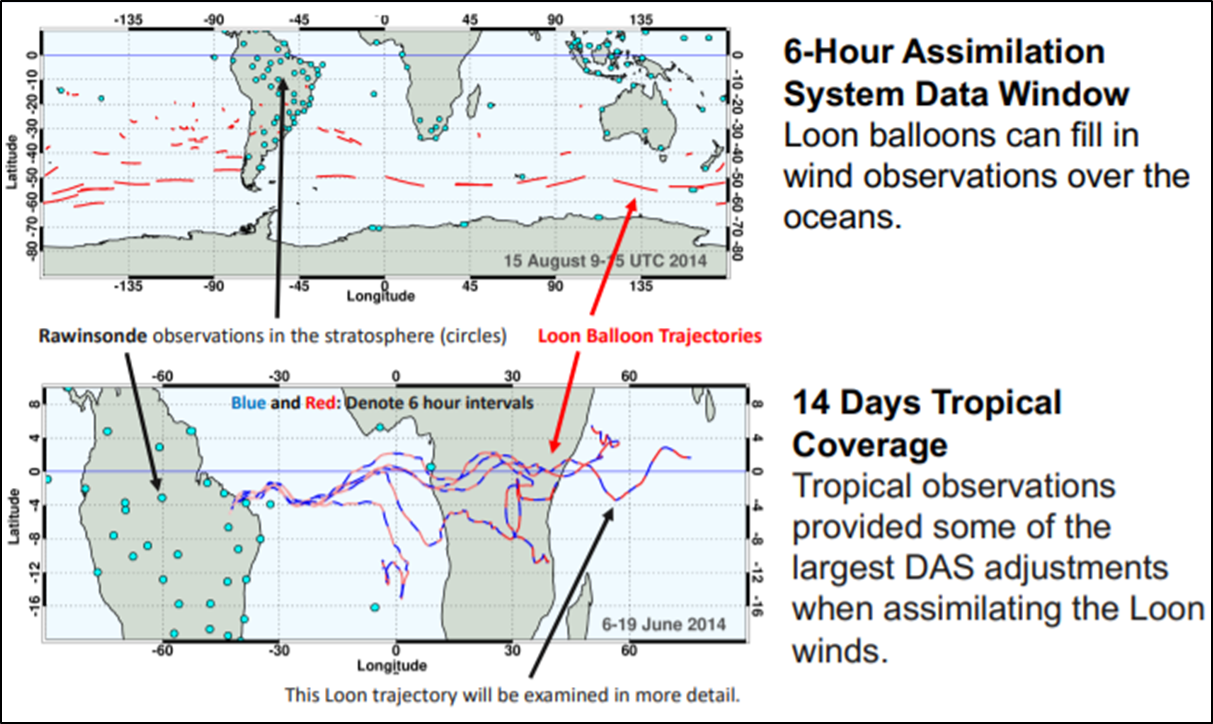Success Stories
SSAIHQ CMS Display Portlet
Success Stories
Breadcrumb
SSAI Obtains and Integrates Loon Stratospheric Balloon Observations for Global Data Assimilation
While satellites routinely measure Earth’s global temperatures from space, in-situ wind measurements are relatively scarce, and consist mainly of a network of ground-based weather balloons. Since only a limited number of the weather balloons reach stratospheric altitudes, and these launches are mostly over Northern Hemisphere land masses, there is a need for additional stratospheric observations, especially over the Southern Hemisphere and tropical oceans. As such, an SSAI-led team successfully employed “Loon” balloons to fill this gap.
Along with improved wind analyses, adding the Loon balloon data to the DAS improved the system’s forecast of the Loon balloon’s position. As such, these results provide direction for future model and analysis improvements.
Overview
Wind information can be obtained through use of experimental super-pressure balloons (SPBs) and can remain in the stratosphere for many months. As the SPBs travel with the winds, they provide in-situ wind observations by reporting their changing positions, including over oceans and other remote regions.  These SPB experiments are generally limited with respect to experimental duration and the number of balloons. However, over the past few years, Project Loon launched hundreds of SPBs (“Loon balloons”), which provided a more consistent set of wind observations in the stratosphere. Coincidentally, the original Loon balloons were intended to provide communication links over remote regions, and thus, were often launched to cover the Southern Hemisphere and tropical oceans, precisely where traditional wind observations are lacking.
These SPB experiments are generally limited with respect to experimental duration and the number of balloons. However, over the past few years, Project Loon launched hundreds of SPBs (“Loon balloons”), which provided a more consistent set of wind observations in the stratosphere. Coincidentally, the original Loon balloons were intended to provide communication links over remote regions, and thus, were often launched to cover the Southern Hemisphere and tropical oceans, precisely where traditional wind observations are lacking.
Results
SSAI team members leveraged this opportunity and began assimilating the Loon balloon winds into the GEOS global data assimilation system (DAS), as part of our work in support of the Global Modeling Assimilation Office (GMAO). The DAS combines all observations with an atmospheric model to produce global analysis of winds and temperatures. Along with improved wind analyses, adding the Loon balloon data to the DAS improved the system’s forecast of the Loon balloon’s position. As such, these results provide direction for future model and analysis improvements.
 Although Loon balloon launches ended in January 2021, there remains a legacy of SPB observation that will soon be included in the new 21st century reanalysis (R21C), a project currently underway by SSAI scientists and team members at the GMAO. This will enable R21C to provide more realistic wind fields in the lower stratosphere, and particularly in the tropics, leading to more accurate modeling into the future.
Although Loon balloon launches ended in January 2021, there remains a legacy of SPB observation that will soon be included in the new 21st century reanalysis (R21C), a project currently underway by SSAI scientists and team members at the GMAO. This will enable R21C to provide more realistic wind fields in the lower stratosphere, and particularly in the tropics, leading to more accurate modeling into the future.

